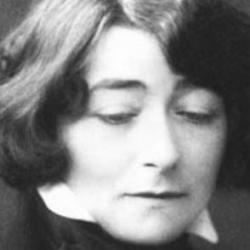Eileen Gray Bibendum Armchair
The Bibendum armchair simultaneously is an unusual and a bold design, which was very impressive at the time. Eileen Gray created this no-frills club armchair in 1927 for Susanne Talbot's apartment in Paris. The armchair looks fresh, new and modern to this day.
With this armchair design Gray again underlined her extravagance in terms of furniture designs. Even 85 years post creation, her furniture, intended for individualists, purists and design lovers, emphasizes a bold but stylish taste.
Her sense of humor, irony and extravagance did not stop at this armchair. The famous Michelin tire man who gained world fame as an advertiser for its famous tire brand of the same name is clearly responsible for the shape of the Bibendum.
It´s not only the armchair´s shape that makes the difference but also its very well existing seating comfort, which gives the seated person an excellent living experience. This unique club armchair has charm, charisma and if you are not careful you will fall immortally in love with its harmonious design. Therefore, the Gray armchair is clearly a special phenomenon in the history of famous furniture designs.
Eileen Gray took inspiration from everyday things to create her masterpieces.
The design of Bidendum armchair combines the boldness of the design with its functionality and delicate dominance that this design exudes. This classic finds its place in spacious living, loft and lounge areas and has tremendous recognition value.
Like all of our furniture, this furniture classic is handcrafted in select Italian workshops.
Dimensions:
- Height approx 73 cm (2'5'') x width approx 90 cm (2'11'') x depth approx 83 cm (2'9'').
Due to the special situation (pandemic, etc.), the production time is from about 10 weeks. In addition, about 5 to 9 working days for delivery. Depending on destination. (As of February 2022)
Available in many variants
The Bibendum armchair can be ordered in different leather variants or in fabric. Frame and tubular steel frames are high-gloss chrome-plated or can be painted in all common RAL colors.
Convincing design
This design armchair convinces with its minimalist aesthetics, function and timeless appearance. Its aura is almost sublime and has yet something cozy about it. The Bibendum fits into any office, living room, men's room or waiting room.
Not only simply copied
Our furniture is not simply copied. They are subject to the highest quality standards using the latest manufacturing techniques. This results in a very durable product which will give you many years of pleasure over and over.
Craftsmanship from Tuscany
Tuscan craftsmanship Made in Italy and years of experience guarantee a high quality finish of the Eileen Gray Bibendum armchair. Nothing is more unaesthetic than a cheap copy that reveals itself as such at first sight.
 More about the designer
More about the designer
Eileen Gray, born on 09.08.1878 in Brownswood (Ireland) was an extraordinary woman.
In the "children's kitchen church" law time Gray moved and went into the professional world. Her autoditactic knowledge led her to success as an interior and furniture designer without ever having completed a degree.
The beginning
Eileen Gray's father died in 1900. At that time she had already been learning the trade of a draughtswoman at the Slade School of Fine Arts in London for two years. In 1902 Gray moved to Paris where she continued to devote herself to the arts of drawing and oriental lacquerwork.
Further Information
In 1907 Gray rented a flat at 21 rue Bonaparte, which she kept until the end of her life. In Paris, Gray met the Japanese Sugawara, who introduced her to the art of East Asian lacquer. It was not until six years later that Gray dared to show her own work at an exhibition of interior designers. Gray's works aroused the interest of the couturier Jacques Doucet - an art connoisseur and collector at the time.
The first project
Doucet was refurnishing a house at the time. The style of the interior design was to move away from 18th century art towards modernism. Eileen Gray made two tables and a screen for the Doucet house. These works were dated and signed by Gray.
Return and creative break
At the outbreak of World War 1, Eileen Gray returned to London and took up work as an ambulance driver. After the end of the First World War, Gray returned to her old place of work, Paris, reopening her workshop. Her first major commission was to design a flat in Rue de Lota of Madame Lévy, known as Suzanne Talbot.
The breakthrough
In 1922 Gray opened the Galerie Jean Désert in the Rue du Faubourg St. Honoré. There she exhibited and sold her furniture, screens and lamps. With her "bedroom-boudoir for Monte Carlo", Gray caused controversial criticism in the Paris press in 1923. Among the followers of the "de Stijl" movement, however, it was highly acclaimed. Gray received encouragement from Gropius, Le Corbusier and Mallet-Stevens. Based on this, she ventured into architecture.
Gray's creativity
With the advice of the architectural theorist Jean Badovici and after several years of learning, Gray built a house for herself in Roquebrune. Well thought out including clever interior solutions and details. The other two projects Gray designed were also convincing in their ingenuity and practicality. Further designs, however, were not realised. Until her death in 1976, Gray worked on various newly conceived projects and was always experimenting with new materials. At the age of 80, Gray converted a barn near Saint Tropez into a summer house. Shortly before her death, Eileen Gray had an exhibition of her most important works at the Museé des Arts Décoratifs in Paris. On 28.11.1976, Gray's eyes closed forever.

 Deutsch
Deutsch
 English
English
 More about the designer
More about the designer